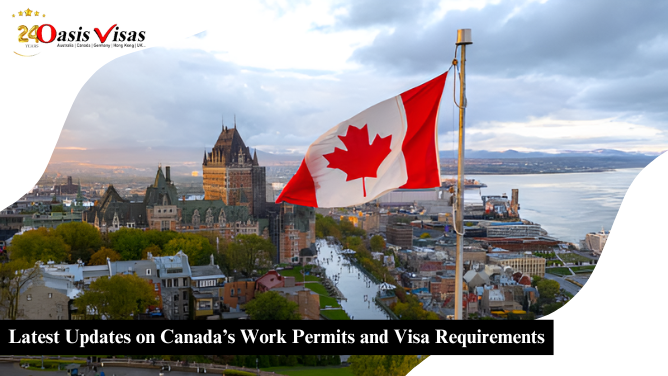
Whether you are considering moving temporarily or permanently, one must stay updated on Canada’s work permits and visa requirements. There are not many destinations for people looking to be career creators and settle in a new country other than Canada. Known for its high quality of life, a strong economy, and kind culture, Canada continues to attract professionals, students, and skilled workers from all over the world.
Immigration policies often change, and updates help one prepare all the better for his or her application process. About new pathways that have emerged to update eligibility criteria, this blog is to cover all important information you must know about Canada’s work permits and how to meet visa requirements.
Canada’s Work Permit Types
There are mainly two types of work permits issued in Canada: Open Work Permit and Employer-Specific Work Permit. An open work permit is one that allows you to work for any employer in Canada, while an employer-specific work permit ties you to one employer where you are obligated to work for the company listed in your permit. There is a need to identify your specific type and know which one best fits your situation.
For instance, an international student who graduates from any Canadian institution may apply for an open work permit, also known as the Post-Graduation Work Permit (PGWP). This is usually used for gaining experience while working in Canada. Likewise, if an applicant already has a confirmed job offer from a Canadian employer, then the applicant needs an employer-specific work permit to match the details of the job offer.
New Developments on Work Permits in Canada
Recently, the work permits for Canada have seen some massive updates. Such changes were intended at making the process smoother for the applicants and at handling the labor shortages in the country. Here are a number of updates that surfaced:
1. Temporary Relaxation of Work Permit Rules for Spouses and Dependents
Canada has provisionally extended the available eligibility for open work permits to spouses and dependents of most temporary foreign workers. This is helping keep families together and encouraging skilled workers to relocate to Canada.
2. Increased Focus on the Global Talent Stream (GTS)
The GTS is one of the fast-track programs aimed at bringing highly skilled workers into Canada. Revisions to the program have reduced processing times for work permits issued under Canada’s program to a mere two weeks for eligible applicants, speeding up work initiation in Canada among tech and engineering professionals.
3. Updated Eligibility Criteria for the PGWP
Graduates from certain online or hybrid programs can now apply for a PGWP, provided the program meets specific requirements. This update accommodates students affected by the pandemic who completed part of their studies online.
4. New Pathways for Healthcare Workers and Tradespeople
To fill critical shortages in healthcare and skilled trades, Canada has introduced new pathways that provide work permits to qualified professionals in these sectors. This includes faster processing and targeted immigration streams.
Steps to Apply for Canada’s Work Permits
Applying for Canada’s work permits is a straightforward process if you follow the correct steps. Here’s a quick guide to help you:
- Identify the Type of Work Permit You Need: Then, find out whether you require an open work permit or an employer-specific work permit. This depends on your circumstances and the type of job to which you are applying in Canada.
- Gather the Needed Documents: A valid passport, job offer letter (where applicable), proof of qualifications, and other supporting evidence, such as medical exams or police clearances, are some usual documents.
- Submit Your Application Online: You can apply through the online process, which is faster and more convenient. Always review your application carefully for errors before making a submission.
- Pay the Application Fee: The fees for a work permit differ with the type of permit. You must therefore be able to pay the correct amount to avoid delays.
- Wait for Processing: The processing time for work permits in Canada varies based on the type of application and your location. Also, always check the latest timelines on the website.
Tips to Meet the Requirements of Your Visa
Apart from your work permit, there are other requirements you might need to meet to enter into Canada. Here are some helpful tips:
- Ensure Financial Stability: Provide proof that you can support yourself and your family while in Canada. Bank statements or proof of income can be used for this.
- Know the Language Requirements: While not all work permits require language tests, a good command of either English or French will strengthen your application and boost your job prospects.
- Stay Up to Date on Biometrics: Many applicants are required to submit biometrics during their application. Find out if that is your case.
Why Canada’s Work Permits Are a Great Opportunity
A work permit in Canada gives you the excellent opportunity to seek new career opportunities and enjoy a great standard of living. For many, this is also a good stepping stone for permanent residency in Canada. Gained work experience from the work permits given by Canada can qualify you for pathways such as Express Entry System and the Provincial Nominee Program (PNP).
Added to that, the country’s economy is still expanding and various business sectors, including technology, healthcare, and construction, provide numerous job openings. If you have the skills in these areas, you should submit your application for Canada’s work permits and begin your integration into a more promising future.
The newest information on the release of Canada’s work permits and visa requirements indicates that the country will continue to court international talent. New pathways, faster processing times, and a more lenient eligibility criteria make the current opportunities for workers much better.
Depending on whether you are a recent graduate, a skilled professional, or a tradesperson, there will be a place for you in Canada. Start preparing your application today and take that very first step towards a successful career in Canada, while keeping watch for the latest government announcements to learn of any further updates on Canada’s work permits.








